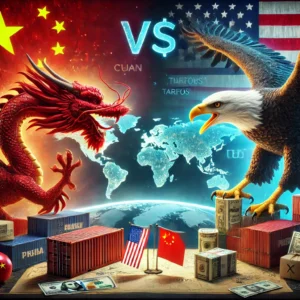In a dramatic escalation of global trade tensions, China has announced retaliatory tariffs of up to 125% on a broad range of U.S. goods, sending shockwaves through international markets and prompting concerns of a renewed trade war between the world’s two largest economies. The sweeping tariff hike, effective immediately, targets key American exports including agricultural products, automobiles, industrial machinery, and electronics.
A Move Triggered by U.S. Tariff Policy
This latest move by Beijing comes in response to recent U.S. actions that increased tariffs on Chinese electric vehicles (EVs), semiconductors, and green technologies. The Biden administration, citing concerns over unfair subsidies and national security risks, had imposed tariffs ranging from 50% to 100% on select Chinese imports just weeks ago. Washington’s goal, officials said, was to counteract China’s dominance in certain strategic sectors and support domestic manufacturing.
In a strongly worded statement from China’s Ministry of Commerce, the Chinese government accused the United States of “economic coercion” and “violations of the principles of fair competition,” warning that further provocations would be met with additional countermeasures.
Economic and Political Implications
The retaliatory tariffs have significant implications, not only for bilateral trade between the U.S. and China but for the global economy at large. U.S. exporters, particularly in agriculture and manufacturing, are bracing for steep losses as their goods become prohibitively expensive in the Chinese market.
Farmers in the Midwest — already facing slim margins — are expected to be hit especially hard. Soybeans, corn, and pork, which were previously key exports to China, are now subject to some of the harshest duties under the new policy. The American Farm Bureau Federation quickly released a statement urging the U.S. government to seek a diplomatic resolution, stating that “America’s rural economy cannot afford to be collateral damage in a trade war.”
Meanwhile, U.S. automakers and tech companies with significant business in China also stand to suffer. Several multinational corporations saw their stocks dip sharply following the announcement, with investors fearing supply chain disruptions and shrinking profits.
Politically, the tariff tit-for-tat is expected to become a major issue in the 2026 midterm elections, with lawmakers divided on how to respond. Some Republicans have called for even tougher sanctions on China, while others warn that escalating tensions could endanger the fragile post-COVID economic recovery.
China’s Strategic Calculus
Beijing’s decision to raise tariffs by such a dramatic margin signals a more assertive stance in global economic negotiations. Analysts suggest that China is attempting to leverage its massive consumer market to deter U.S. aggression, betting that American industries dependent on Chinese demand will pressure Washington to reverse course.
Additionally, China’s move appears aimed at galvanizing domestic support amid a slowing economy and increasing international scrutiny over its policies in the South China Sea, Taiwan, and Hong Kong. By taking a hard line against perceived foreign interference, Chinese President Xi Jinping is reinforcing a narrative of national resilience and sovereignty.
Global Markets and Ripple Effects
Global markets reacted swiftly to the announcement. Major indices in Asia and Europe opened lower, and Wall Street followed suit, with the Dow Jones Industrial Average dropping over 700 points in early trading. Commodity prices, especially for soybeans and crude oil, also experienced volatility.
Beyond the U.S. and China, the trade dispute threatens to drag other economies into the fray. Nations in Europe and Asia, already caught between the two superpowers, may be forced to choose sides or risk being caught in the economic crossfire. The World Trade Organization (WTO) has urged both nations to return to the negotiating table, warning that continued escalation could destabilize global trade flows and hinder growth.
What Comes Next?
As tensions rise, the path forward remains uncertain. Both sides have indicated a willingness to negotiate, but neither appears ready to back down. The Biden administration has called for high-level talks to prevent further economic damage, though it has not indicated any intention to roll back its own tariffs.
China, for its part, has left the door open for dialogue but insists that the U.S. must first take “concrete steps” to repair the relationship.
In the meantime, businesses, investors, and consumers around the world will continue to navigate an increasingly unpredictable economic landscape. With inflation still a concern and global supply chains not fully recovered from pandemic disruptions, the escalating tariff battle could hardly come at a worse time.
Conclusion
The imposition of 125% tariffs by China marks a dangerous turning point in U.S.-China relations and could usher in a prolonged period of economic confrontation. While the political motivations behind the moves are complex, the real-world impacts will be felt across continents — from farms in Iowa to factories in Guangdong. Unless cooler heads prevail and diplomacy takes precedence, the world may be entering a new era of economic fragmentation and protectionism.



